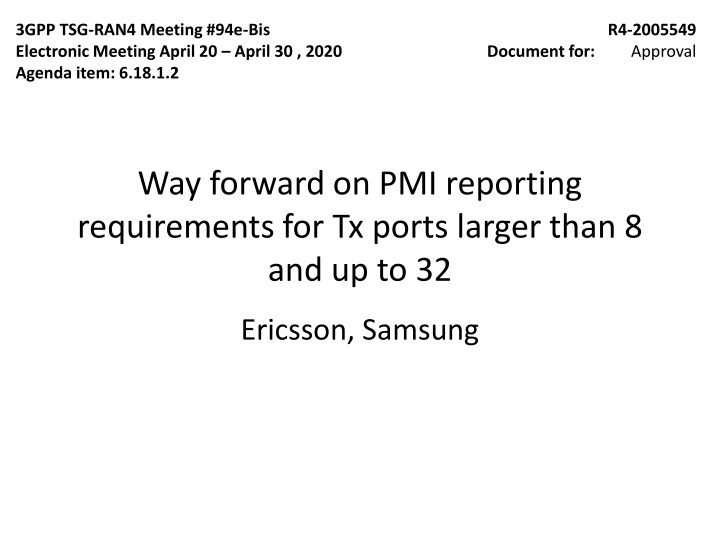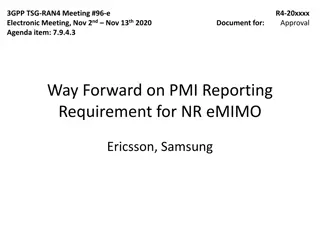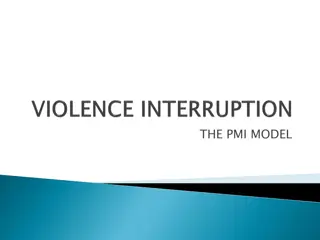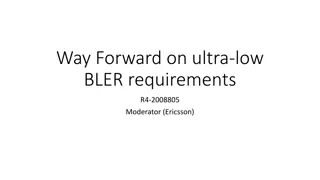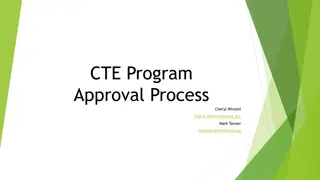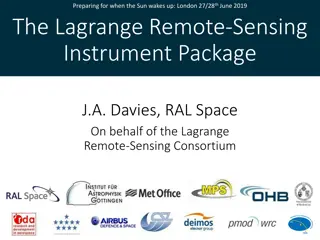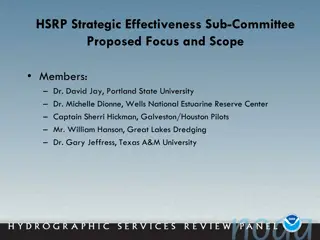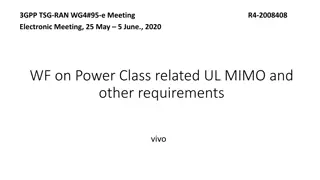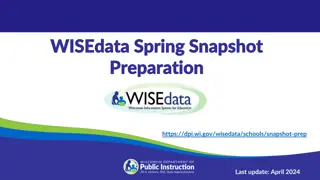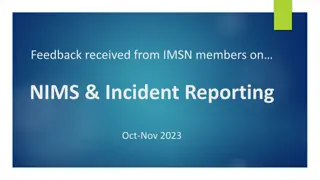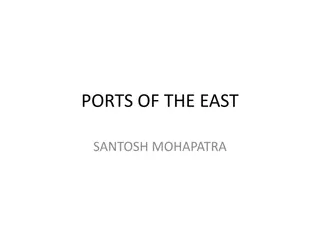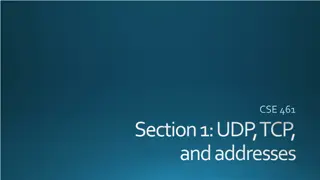Approval Document for Way forward on PMI reporting requirements for Tx ports
Agenda item 6.18.1.2 at the 3GPP TSG-RAN4 Meeting #94e-Bis Electronic Meeting discusses PMI reporting requirements for Tx ports larger than 8 and up to 32. Various companies such as Ericsson, Samsung, Qualcomm, Intel, Apple, and Huawei are involved in proposing options for wideband and subband PMI requirements based on the number of Tx ports. The meeting covers topics like wideband PMI requirements, duplex mode, subband sizes, configuration parameters, and the need for alignment among companies' results. Detailed simulation assumptions are outlined in the meeting documents.
Download Presentation

Please find below an Image/Link to download the presentation.
The content on the website is provided AS IS for your information and personal use only. It may not be sold, licensed, or shared on other websites without obtaining consent from the author.If you encounter any issues during the download, it is possible that the publisher has removed the file from their server.
You are allowed to download the files provided on this website for personal or commercial use, subject to the condition that they are used lawfully. All files are the property of their respective owners.
The content on the website is provided AS IS for your information and personal use only. It may not be sold, licensed, or shared on other websites without obtaining consent from the author.
E N D
Presentation Transcript
3GPP TSG-RAN4 Meeting #94e-Bis Electronic Meeting April 20 April 30 , 2020 Agenda item: 6.18.1.2 R4-2005549 Approval Document for: Way forward on PMI reporting requirements for Tx ports larger than 8 and up to 32 Ericsson, Samsung
Timeline of previous agreements #92 WF: R4-1910017 #92bis WF: R4-1912834 simulation assumptions: R4-1912811 #93 WF: R4-1915858 Simulation assumptions: R4-1915859 #94e WF: R4-2002393 Simulation assumptions: R4-2002394
PMI tests SP Type I page 1 Wideband PMI requirements 32Tx ports PMI requirements for 16 Tx ports Option 1: Introduce subband PMI requirements for 16 Tx ports (Samsung, Ericsson, Qualcomm, Intel, Apple) Option 2: Not introduce subband PMI requirements for 16Tx ports and covers 16 Tx port requirements with wideband PMI (Huawei, Ericsson)
16Tx ports SP Type I page 2 Duplex mode: FDD 10MHz/15kHz BW/SCS TDD 40MHz/30kHz BW/SCS Number of Rx antennas: 2Rx, and 4Rx Subband size (if applicable) FDD: 8 TDD: 16
NZP-CSI-RS configuration SP Type I page 3 16Tx ports: (k0, k1, k2, k3) = (2, 4, 6, 8), l0 = (5) 32Tx ports: (k0, k1, k2, k3) = (2, 4, 6, 8), (l0, l1) = (5, 12)
Result collection SP Type I page 4 Further alignment needed given current divergency amonst companies results. Detailed simulation assumptions found in tdoc R4-2005550
Parameters for Type II page 1 Codebook construction Option 1: 16Tx ports (N1,N2) = (4,2), (O1, O2) = (4,4) (Huawei, Samsung, QC, CTC, Apple) Option 2: 32Tx ports (N1,N2) = (4,4), (O1, O2) = (4,4)(Ericsson) L (numberOfBeams) 2 Npsk (phaseAlphabetSize) Option 1: 4 (Huawei, Samsung) Option 2: 8 (QC, Apple) Option 3: TBD depend on whether to introduce MU-MIMO test setup (Ericsson) SubbandAmplitude Option 1: False (Huawei, Samsung, Apple) Option 2: True (QC) Option 3: TBD depend on whether to introduce MU-MIMO test setup (Ericsson) PMI-FormatIndicator Option 1: Wideband (Huawei, Samsung) Option 2: Subband (Qualcomm, Apple) Option 3: TBD depend on whether to introduce MU-MIMO test setup (Ericsson) Propagation condition Option 1: TDLA30-5 (baseline in RAN4 #94e, Huawei, Qualcomm, Apple) Option 2: TBD depend on whether to introduce MU-MIMO test setup (Ericsson) MIMO correlation Option 1: XP High (Huawei, Qualcomm, Apple) Option 2: XP Medium (Samsung) Option 3: TBD depend on whether to introduce MU-MIMO test setup (Ericsson)
Parameters for Type II page 2 MCS and rank Option 1: As baseline, use MCS 20, rank 2 (Samsung, Huawei, Qualcomm, Apple) Option 2: TBD depend on whether to introduce MU-MIMO test setup (Ericsson) Beam steering model Option 1: Reusing beam steering approach with dual-cluster beams as specified in B.2.3B.4A of TS 36.101 (Samsung, Qualcomm) Option 2: Use Equation 1 as beam steering model for Type II codebook performance requirements. (Huawei, Samsung, Ericsson) Option 3: Use option 1 if L = 2, and use option 2 if L > 2 (CTC) Test metric Option 1: TP ratio between following PMI and rand PMI (Samsung, Huawei, Qualcomm, CTC, Apple) Option 2: MU-MIMO test setup comparing type II codebook with type I (Ericsson) Multi-user scheduling Option 1: Consider the multi-user scheduling for the type-II PMI reporting test (Ericsson) Option 2: Not to consider the multi-user scheduling for the type-II PMI reporting test (Huawei, Samsung, Qualcomm, CTC, Intel, Apple)
Beam steering model for L number of beams ? 2 1 ?? (?) (?) ?? + ? + ? = ?????,1,??,2 ?????,1,??,2 ? ?=2 2 ? ?=2 2 1 + 1 + ?? ?? ?= 2 And the steering matrix is further expressed as following: ( 1 , 1 , 2 , 1 , 1 0 ) 1 0 ( ) ( ) = D D N D N 2 2 , k k k k where - ??, ?? are independent channels for the first beam and the consecutive i beams with the NrxNtchannel matrix per subcarrier. - ?? is the relative power difference from the first beam. ( m ) (?) D - , ???,1,??,2 are the steering matrix for first beam and consecutive i number of beams , k 1 , k 2 , - is the steering matrix in first dimension with same polarization, ( ) D 1 ,N k 1 - is the steering matrix in second dimension with same polarization, ( ) D N 2 2 , k - N is the number of antenna elements in first dimension with same polarization, 1 - N is the number of antenna elements in second dimension with same polarization, 2
